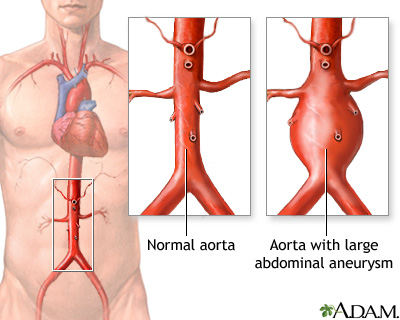Abdominal aortic aneurysm
Alternative Names-Aneurysm aortic; AAA
Abdominal aortic aneurysm (AAA), also known as a triple-a, is a localized enlargement of the abdominal aorta such that the diameter is greater than 3 cm or more than 50% larger than normal.
The aorta is the main blood vessel that supplies blood to the abdomen, pelvis, and legs. An abdominal aortic aneurysm occurs when an area of the aorta becomes very large or balloons out.
.
Causes
The exact cause of the condition is unknown. Factors that can increase your risk of developing the problem include:
Aneurysms can develop slowly over many years, often with no symptoms. Symptoms may come on quickly if the aneurysm expands rapidly, tears open or leaks blood within the wall of the vessel (aortic dissection).
Symptoms of rupture include:
Your doctor will examine your abdomen and feel the pulses in your legs. The doctor may find:
You may have an abdominal aortic aneurysm that is not causing any symptoms. Your doctor may find this problem by doing the following tests:
If you have bleeding inside your body from an aortic aneurysm, you will need abdominal aortic aneurysm repair.
There are two types of surgery:
To reduce the risk of aneurysms:The best approach to prevent an aortic aneurysm is to keep your blood vessels as healthy as possible. That means taking these steps:
Alternative Names-Aneurysm aortic; AAA
Abdominal aortic aneurysm (AAA), also known as a triple-a, is a localized enlargement of the abdominal aorta such that the diameter is greater than 3 cm or more than 50% larger than normal.
The aorta is the main blood vessel that supplies blood to the abdomen, pelvis, and legs. An abdominal aortic aneurysm occurs when an area of the aorta becomes very large or balloons out.
.
Causes
The exact cause of the condition is unknown. Factors that can increase your risk of developing the problem include:
- High blood pressure
- Smoking
- Genetic factors
- Infection in the aorta (vasculitis)- In rare cases, abdominal aortic aneurysm may be caused by an infection or inflammation that weakens a section of the aortic wall.
- Hardening of the arteries (atherosclerosis)- Atherosclerosis occurs when fat and other substances build up on the lining of a blood vessel, increasing your risk of an aneurysm.
Risk factors
Abdominal aortic aneurysm risk factors include:
SymptomsAbdominal aortic aneurysm risk factors include:
- Tobacco use- Tobacco use is a strong risk factor for the development of an abdominal aortic aneurysm. The longer you've smoked or chewed tobacco, the greater your risk.
- Age-Abdominal aortic aneurysms occur most often in people age 65 and older.
- Being male.-Men develop abdominal aortic aneurysms much more often than women do.
- Atherosclerosis- Atherosclerosis, the buildup of fat and other substances that can damage the lining of a blood vessel, increases your risk of an aneurysm.
- Family history-People who have a family history of abdominal aortic aneurysm are at increased risk of having the condition. People who have a family history of aneurysms tend to develop aneurysms at a younger age and are at higher risk of rupture.
Aneurysms can develop slowly over many years, often with no symptoms. Symptoms may come on quickly if the aneurysm expands rapidly, tears open or leaks blood within the wall of the vessel (aortic dissection).
Symptoms of rupture include:
- Pain in the abdomen or back. The pain may be severe, sudden, persistent, or constant. It may spread to the groin, buttocks, or legs.
- Dizziness
- Clammy skin
- Rapid heart rate
- Nausea and vomiting
- Shock
Your doctor will examine your abdomen and feel the pulses in your legs. The doctor may find:
- Pulsating sensation in the abdomen
- Stiff or rigid abdomen
- A lump (mass) in the abdomen
You may have an abdominal aortic aneurysm that is not causing any symptoms. Your doctor may find this problem by doing the following tests:
- CT scan of the abdomen to confirm the size of the aneurysm
- Ultrasound of the abdomen when the abdominal aneurysm is first suspected
- Any one of these tests may be done when you're having symptoms.
- CTA (computed tomographic angiogram) to help with surgical planning
If you have bleeding inside your body from an aortic aneurysm, you will need abdominal aortic aneurysm repair.
- If the aneurysm is small and there are no symptoms:Surgery is rarely done
- Surgery is done if the aneurysm is bigger than 2 inches (5.5 cm) across or growing quickly. The goal is to do surgery before complications develop.
There are two types of surgery:
- Endovascular stent grafting-This procedure can be done without making a large cut in your abdomen, so you may recover more quickly. This may be a safer approach if you have certain other medical problems. Endovascular repair can sometimes be done for a leaking or bleeding aneurysm.
- Traditional (open) repair-A large cut is made in your abdomen. The abnormal vessel is replaced with a graft made of man-made material.
To reduce the risk of aneurysms:The best approach to prevent an aortic aneurysm is to keep your blood vessels as healthy as possible. That means taking these steps:
- Keep your blood pressure under control.
- Eat a heart-healthy diet, exercise, stop smoking (if you smoke), and reduce stress.
- If you have high blood pressure or diabetes, take your medicines as your doctor has told you.
- Quit smoking or chewing tobacco.
- Reduce cholesterol and fat in your diet.
- Get regular exercise.
- People over age 65 who have ever smoked should have a screening ultrasound done once.

